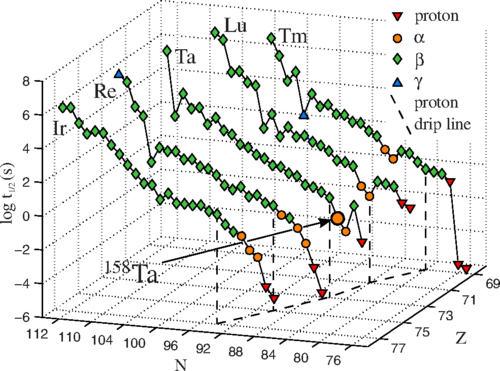There is a lot left to learn. Beyond the stable nuclei that we find on Earth, there are many unstable nuclei that are formed in stellar events such as supernovae, but which are short-lived. There is a limit to how many protons and neutrons a nucleus can hold – too many and the excess will literally ‘pop out’. These limits are known as the proton and neutron ‘drip lines’.
Although these drip lines can be calculated, getting experiments to agree is another issue. Even finding them experimentally can be a difficult prospect.
A new study by the University of Liverpool, STFC’s Daresbury Laboratory and the University of Jyväskylä has discovered that nuclei can exist in special states that blur the boundaries of existence - behavior of isotopes that are so rare they might only exist momentarily during stellar explosions. Until now, these could have only been predicted through calculations; but the reality was proving to be very different to theory.

Measured half-lives of longest-living states of neutron-deficient Tm, Lu, Ta, Re, and Ir isotopes. Main decay modes are indicated by symbols given in the key. The solid lines connect successive data points from Ref. [3] for each element. The dashed lines indicate the proton drip line, beyond which proton emission from nuclear ground states is energetically possible (Qp>0). No states are known in nuclei beyond the lightest isotopes shown. DOI: 10.1103/PhysRevLett.112.092501
Using spectrometers, the researchers report experimental discovery of an isomer of tantalum with a structure that allows it to live longer than expected before decaying. This multiparticle spin-trap isomer 2,668 keV above the known 9+ state and has a spin 10ℏ higher and negative parity. The 19− isomer also has an 8644(11) keV, 1.4(2)% α-decay branch that populates the
9+ state in 154Lu (lutetium). No proton-decay branch from the isomer was identified, despite the isomer being unbound to proton emission by 3261(14) keV.
That is remarkable stability against proton emission is compared with theoretical predictions.
The University of Liverpool’s Professor Robert Page, who led the research, said, “We usually think of nuclear ground states as being the most stable, but these results show that certain excited states have enhanced stability and could extend the range of observable nuclei far beyond the drip lines.”
Citation: R. J. Carroll, R. D. Page, D. T. Joss1, J. Uusitalo, I. G. Darby1, K. Andgren, B. Cederwall, S. Eeckhaudt, T. Grahn, C. Gray-Jones, P. T. Greenlees, B. Hadinia, P. M. Jones, R. Julin, S. Juutinen, M. Leino, A.-P. Leppänen, M. Nyman, D. O’Donnell, J. Pakarinen, P. Rahkila2, M. Sandzelius, J. Sarén, C. Scholey, D. Seweryniak, and J. Simpson, 'Blurring the Boundaries: Decays of Multiparticle Isomers at the Proton Drip Line', Phys. Rev. Lett. 112, 092501 – Published 4 March 2014 DOI: 10.1103/PhysRevLett.112.092501





Comments